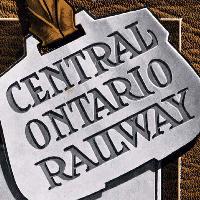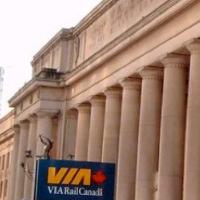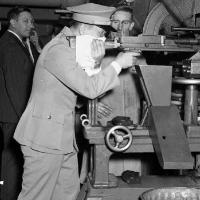
Our Home from 1938 - 1946
Union Station is eight stories tall and features a massive lobby known as the Great Hall, numerous corridors at the top, and a shooting range used by Canadian National Gun Association.
While VIA Rail, the successor to the railways that originally built Union Station, continues to use it as a major hub for the Quebec City-Windsor Corridor (including the joint VIA-Amtrak Maple Leaf train to New York City) and the eastern terminus of The Canadian, the vast majority of passengers travelling through the station are from GO Transit's commuter trains. Toronto Transit Commission riders likewise outnumber VIA passengers. The station was used by Ontario Northland trains to northern Ontario. In 2015 service to Pearson International Airport began via the Union/Pearson Express.
Union Station is one of the few large railway stations in North America to use through-train operation. That is, the train platforms are through lines rather than lines which terminate in the station, as in stub-end operation.
Visit the Toronto Union Station web site.
67 Years at Hanna Avenue
The Model Railroad Club of Toronto was fortunate in having its home in the same premises from January 1946 to April 2013, occupying two former Bren gun test ranges in a building purpose-built for gun production during World War II. At the conclusion of the war, the Canadian Government leased the building to commercial tenants and in 1950 sold the property to a company formed by a majority of those tenants. The Model Railroad Club of Toronto was the first tenant to occupy the building in 1946, became a shareholder / tenant in 1950, and was the last surviving tenant of that era to leave, a span of over 67 years.
The photo is of a Chinese Army official test firing a gun on February 27, 1942 in the north room of the two 120’ x 20’ former firing ranges the Club occupied.


The Club is open to visitors on
Thursdays 7pm to 9pm
and some Saturdays 1pm to 3pm.
Please call in advance for Saturdays.
The Real Central Ontario
The Central Ontario Railway had been running for thirty-two years before succumbing to Mackenzie and Mann, builders of the Canadian Northern Railway, to feed their main line between Toronto and Ottawa. The first train ran from Picton to Trenton in 1880 under its original name, the Prince Edward County Railway. Two years later, as the Central Ontario Railway, multiple expansions began in order to reach the areas of relatively unexploited iron ore discoveries recently found to the north. The intention was to connect with the Canada Atlantic Railway (later absorbed by the Grand Trunk Railway) near Whitney, but they didn't quite make it. Construction was halted some eight miles away and never resumed. Despite the railway's reliance on the mining industry, haulage of farmers' produce and sawn lumber proved to be steady, as did passenger traffic.
Today’s Central Ontario as it is presented in model form, is a loose representation of the original. While our town’s are named after Club members, we endeavour to name passenger cars after towns along the original route as well as trying to capture some of the flavour of that era through the types of industries we have built on our layout.
Click on the photo for a full pdf of the timetable.
The Model Railroad Club of Toronto was founded
in 1938 by Harry Ebert
and Borden Lilley.
Originally located in Harry Ebert’s basement, the Model Railroad Club of Toronto (MRCT) soon moved to new premises at Toronto’s Union Station.
Following World War II, the railways required the Union Station space the
Club occupied, so a hunt for a new home
was on. In January 1946, the Club moved to its long-time location in the basement of 171 East Liberty Street (formerly
37 Hanna Avenue), a former munitions factory. In April 2013 the Club relocated
to 11 Curity Avenue, Toronto. Over the past 87 years a great many have belonged to the Club and enjoyed themselves through fellowship with
others that share their passion for the hobby. For many, membership at the Model Railroad Club of Toronto has
been a lifelong commitment.
The Model Railroad Club of Toronto, Inc. is incorporated as a non-profit corporation under the Ontario Corporations Act.






